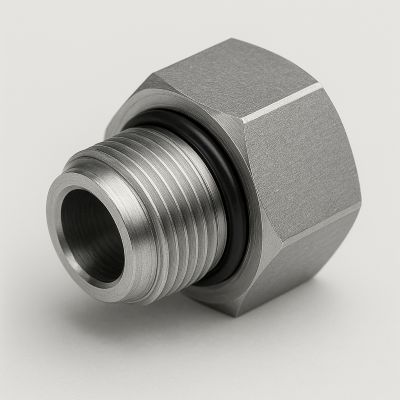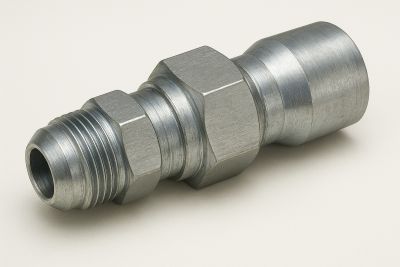When it comes to hydraulic and aerospace systems, selecting the right fitting is critical to ensuring safety, performance, and long-term reliability. Among the most commonly used options are ORB (O-Ring Boss) fittings and AN (Army-Navy) fittings.
Both have distinct designs, sealing methods, and performance characteristics that directly affect system efficiency. In this guide, we’ll explore the differences between ORB and AN fittings, including their definitions, working principles, applications, and comparative advantages.
If you have any questions or need product recommendations, feel free to contact our team.
What is an ORB fitting?
ORB (O-Ring Boss) fittings are designed for fluid and gas systems that require a leak-free seal. They use an O-ring seated in a machined groove to create a secure connection when tightened, making them ideal for high-pressure environments.
ORB fittings are widely used in automotive, industrial, and hydraulic systems, where reliable sealing and easy maintenance are essential.
How does ORB Fittings Work?
ORB fittings seal by compressing the O-ring between the male and female components. As the fitting is tightened, the O-ring is pressed against the mating surface, forming a tight, leak-proof seal.
This design is particularly useful in high-pressure applications where even minor leaks are unacceptable.
Common ORB Fitting Sizes
|
Size |
Typical Use Case |
Description |
|
1/8″ |
Small hydraulic systems |
Suitable for low-volume applications |
|
1/4″ |
General industrial use |
Common in standard fluid systems |
|
1/2″ |
Heavy-duty operations |
Handles higher pressure levels |
|
3/4″ |
High-flow systems |
Used in automotive and fluid transport setups |
ORB fittings are available in a wide range of sizes, offering flexibility for everything from small-scale machinery to large hydraulic systems.
What Is an AN Fitting?
AN (Army-Navy) fittings were originally developed for military aviation but are now used in automotive, aerospace, and performance industries.
They are known for their durable, high-pressure, and vibration-resistant design, making them suitable for critical systems such as fuel, oil, and hydraulic lines.
How AN Fittings Work
AN fittings rely on a 37-degree flared connection to form a metal-to-metal seal. When tightened, the flare nut and fitting body compress together, preventing leaks without the need for O-rings or sealants.
This mechanical seal ensures excellent reliability even in extreme vibration or temperature conditions.
Common AN Fitting Sizes
|
Size |
Typical Use Case |
Description |
|
AN-4 |
Aircraft and military systems |
Common for fuel lines |
|
AN-6 |
High-performance racing |
Designed for high-flow applications |
|
AN-8 |
Automotive fuel systems |
Used for oil and fuel lines |
|
AN-12 |
Heavy-duty hydraulics |
Built for larger, high-pressure systems |
AN fittings are measured in sixteenths of an inch (for example, AN-8 = 8/16″ or 1/2″). They are engineered for durability, precision, and superior performance.
ORB vs AN Fittings: Detailed Comparison
Both fittings serve unique purposes, but their designs, sealing mechanisms, and performance levels differ significantly.
Structural & Design Differences
1. Thread Types
-
ORB Fittings: Use straight threads and an O-ring for sealing.
-
AN Fittings: Use 37-degree flared threads that create a mechanical, metal-to-metal seal.
2. Sealing Mechanisms
-
ORB Fittings: Depend on an O-ring to prevent leaks.
-
AN Fittings: Rely on a flared metal connection; sometimes PTFE tape or sealant is added for reinforcement.
3. Size Standards & Interchangeability
-
ORB and AN fittings follow different size standards and are not directly interchangeable. Adapters are required when connecting the two systems.
Performance Comparison
1. Pressure Handling Capacity
-
ORB Fittings: Medium to high pressure (up to ~6,000 PSI depending on material and size).
-
AN Fittings: Designed for higher pressure (up to 10,000 PSI or more) in aerospace or defense-grade systems.
2. Vibration Resistance
-
ORB Fittings: Perform well under moderate vibration.
-
AN Fittings: Built for extreme vibration environments, ideal for aircraft and racing applications.
3. Temperature Adaptability
-
ORB Fittings: Operate reliably between -40°F and 250°F, depending on the O-ring material.
-
AN Fittings: Withstand higher temperatures and extreme thermal conditions.
Application Scenarios
➡️ ORB Fittings
-
Automotive hydraulics
-
Industrial machinery
-
General fluid transport systems
➡️ AN Fittings
-
Aerospace and defense systems
-
High-performance automotive engines
-
Heavy-duty hydraulic equipment
Summary: ORB vs AN Fittings
|
Feature |
ORB Fittings |
AN Fittings |
|
Thread Type |
Straight thread with O-ring |
37° flare thread |
|
Seal Type |
O-ring seal |
Metal-to-metal seal |
|
Pressure Rating |
Up to 6,000 PSI |
Up to 10,000+ PSI |
|
Vibration Resistance |
Moderate |
Excellent |
|
Temperature Range |
-40°F to 250°F |
Higher temperature tolerance |
|
Applications |
Automotive, industrial, hydraulic |
Aerospace, racing, military |
|
Cost |
More affordable |
Higher cost due to precision design |
|
Interchangeability |
Requires adapter |
Requires adapter |
Can ORB and AN Fittings Be Interchanged?
Direct interchange is not possible due to differences in thread design and sealing style. However, ORB-to-AN adapters can be used to connect systems that utilize both fitting types safely and effectively.
Why You Need to Connect ORB and AN Systems
As industries overlap, it’s increasingly common to mix hydraulic and automotive components. A custom hydraulic pump might use ORB ports, while a high-performance hose assembly comes with AN ends.
➡️ Typical scenarios include:
-
Engine swaps and performance upgrades
-
Hydraulic system retrofits and repairs
-
Custom fluid routing in industrial or racing applications
➡️ Instead of replacing entire assemblies, using ORB to AN adapter fittings provides:
-
Cost and time savings
-
Design flexibility for mixed-standard systems
-
A cleaner, more modular setup for custom projects
Conclusion
As engineering systems evolve and cross-industry integration becomes the norm, ORB to AN fittings provide an elegant, practical solution to bridge two trusted standards. They deliver leak-free performance, flexibility, and cost savings, all in a compact, easy-to-use design.
Whether you’re designing a custom hydraulic system or upgrading a high-performance engine, choosing the right ORB to AN adapter ensures safe, efficient, and reliable connections for years to come.
Explore a full range of ORB to AN fittings today and simplify your next project with confidence.
FAQ: ORB vs AN Fittings
How tight should ORB fittings be?
Tighten according to the manufacturer’s torque specifications. Over-tightening can damage the O-ring and cause leaks.
How do you measure an ORB fitting?
Measure the outer diameter of the male threads and the inner diameter of the female threads. Check the thread pitch and O-ring groove for accuracy.
Are ORB and AN fittings the same?
No. ORB fittings use an O-ring seal, while AN fittings use a 37° flare. Their thread types and applications differ.
What does ORB stand for?
ORB stands for O-Ring Boss, referring to the O-ring used for sealing.
What’s the difference between NPT and ORB fittings?
NPT fittings use tapered threads for sealing, while ORB fittings use straight threads with an O-ring, offering better leak resistance and easier maintenance.
Where can I buy quick coupler or hydraulic fittings?
Contact Sannke for a full range of custom hydraulic, ORB, and AN fittings designed for industrial and aerospace applications.
Post time: Nov-05-2025



